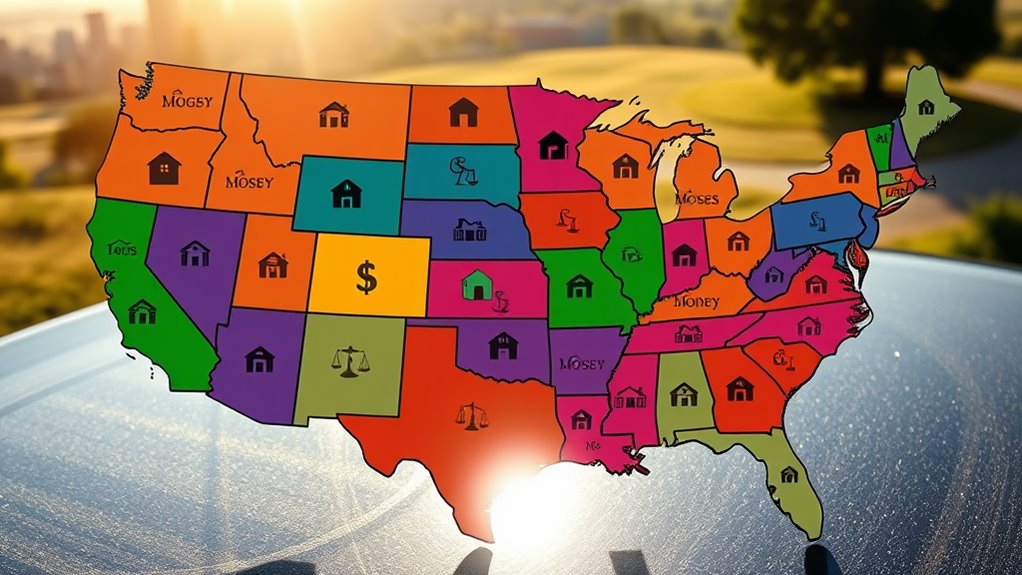Why Non-Owner Insurance Varies by State?
In California, non-owner insurance can cost markedly more than in Texas due to varying minimum liability requirements and claim frequencies. This disparity stems from local laws that dictate coverage levels, which in turn affect premium rates. Meanwhile, competition among insurers can influence pricing strategies. Understanding these state-specific factors is vital, as they can dramatically impact your options and costs for non-owner car insurance. What other elements contribute to these differences?
When considering non-owner insurance, it's important to recognize that costs can vary greatly from state to state. Nationwide, the average annual cost for non-owner car insurance is around $325, but this figure masks considerable discrepancies. For instance, if you live in Iowa, you could pay as little as $153 annually, while in Florida, you might find yourself shelling out $545. Such variations stem from a blend of state-specific regulations, market competition, and local insurance providers, which can often offer more competitive rates than their national counterparts. Understanding SR-22 insurance requirements in your state can also affect your policy choices.
Each state mandates different minimum liability coverage levels, which directly affects your policy's price. For example, states with higher required coverage might lead to increased premiums. Furthermore, local laws and regulations play an important role in determining these rates. In some states, unique regulations regarding non-owner policies could influence not only availability but also the overall pricing structure. States with higher claim frequencies tend to see elevated premiums, as insurers adjust their rates to account for increased risk.
Demographic factors also contribute considerably to rate differences. Younger drivers often face higher premiums due to their inexperience on the road, while gender can further skew rates, with men generally classified as higher-risk drivers. Your credit score, driving history, and even your employment status may also come into play, impacting the overall cost of your non-owner insurance. For instance, a clean driving record can lead to lower rates, while multiple accidents or violations can cause your premiums to skyrocket. Additionally, rates for non-owner insurance may be influenced by age, gender, driving record, and credit history.
Company variations add another layer of complexity. Major insurers like State Farm and USAA offer competitive rates, with State Farm providing one of the cheapest national non-owner insurance policies at approximately $213 annually. However, regional companies like Texas Farm Bureau may offer even lower rates in specific areas. It's worth noting that some insurers mightn't provide non-owner policies at all, or they could make the purchasing process cumbersome, forcing you to explore multiple options to find the best fit.
The coverage types associated with non-owner insurance are typically limited to liability coverage, meaning they don't cover any damage to the vehicle you're driving. This limitation is vital to remember, especially since these policies act as secondary coverage to the owner's insurance. Some policies may offer additional coverage for uninsured motorists, but extensive and collision coverage are generally excluded.
Changes in state laws can also influence insurance costs greatly. Legal reforms might alter minimum liability coverage requirements, leading to fluctuations in premium rates. Additionally, state funding for insurance programs and tax laws can indirectly affect your costs.
With these factors in mind, understanding the regional implications and variations in non-owner insurance across states becomes essential. Whether you're considering purchasing a policy or simply evaluating your options, being informed about these nuances can save you money and help you find the best coverage for your needs.
Conclusion
In conclusion, non-owner insurance varies widely by state due to factors like liability requirements, claim frequencies, and local regulations. It's a complex web of influences, where one state's competitive market might offer you a lower premium, while another's strict laws could leave you paying more. So, when traversing the landscape of non-owner insurance, think of it as a puzzle—each piece shaped by your state's unique characteristics, ultimately determining your coverage costs.
